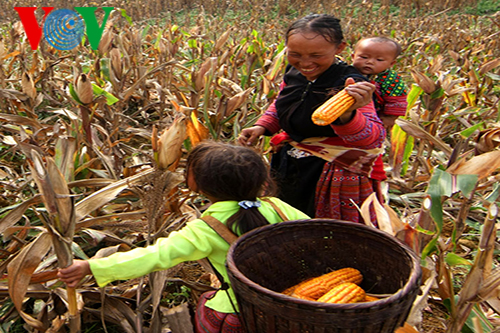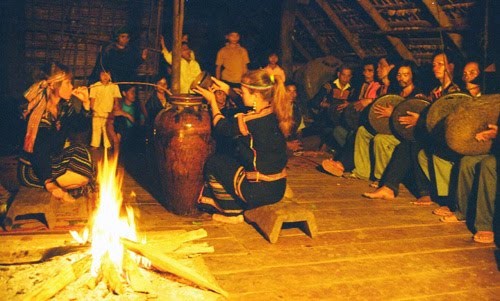 Maize is the main staple of the H'Mong in Ha Giang province Maize is the main staple of the H'Mong in Ha Giang province |
The H’Mong in Ha Giang province accounts for the largest percentage of ethnic groups in the province, at over 31 percent living in the region. Surrounded by sharp-edged outcroppings and rugged rocks rising to the sky, the locals created a unique cultivation method: planting crops like maize and vegetables between the rocks. Maize is their main staple. They use it to make Men Men or steamed ground maize for their daily meal and boiled maize cake, an indispensable dish for the traditional Lunar New Year holiday.
The H’Mong consider maize cake an omen of luck for the New Year. Vang Chan Giao, a researcher of the H’Mong culture in Ha Giang province, said: “While the Kinh, Tay, and Nung groups have long used glutinous rice to make chung (square sticky rice cakes) and day (round sticky rice cakes) as offerings to worship their ancestors during Tet, boiled maize cake is the traditional dish the H’Mong who believe it tells the fortune of the new lunar year. If any cake can’t float when they are boiled, it’s an omen for an unfortunate year. If all cakes float, it’s the sign for a prosperous and healthy year ahead. The tradition of making boiled maize cakes during Tet has been passed down through generations of the H’Mong.”
H’Mong people start to make the cake at the beginning of the last lunar month of the year. It takes more time and effort to make the floating maize cake than floating rice cake. The cake must be white, fragrant and sticky. After chosen and sieved carefully, the maize is rubbed down, then soaked in water for a month to make them tender. The water must be changed frequently to prevent the maize from being fermented. Then, the maize is ground. It takes from 2 to 3 days for the ground maize to get dry to be ready for making.
When boiling, the fire must be kept stable. Only when the water is boiled can the molded cake float. Hau Thi Chau, a local H’Mong in Ha Giang province, said: “We work very hard all year round. When Tet comes, the H’Mong people always make floating maize cakes. Only good maize is chosen. After sieving, they are soaked in water. We change the water once to twice per week to make sure the maize doesn’t get fermented. 2 to 3 days ahead of the New Lunar Year, we grind it and leave it to dry. On the 30th of the last lunar month, we start to cook it. The cakes need to be boiled again after 3 or 4 days.”
The cake is usually eaten with cane sugar. Once boiled, it is served in bowls, accompanied by several slices of cane sugar. All H’Mong families cook big pots of floating maize cakes to pray for a New Year of luck, health, and happiness.
 Jar wine is an indispensable drink for the Tet celebration of the Ede in Dak Lak Jar wine is an indispensable drink for the Tet celebration of the Ede in Dak Lak |
Tthe Ede ethnic minority group in Dak Lak Central Highlands province make their jar wine, an indispensable drink for the Tet celebration. As a specialty of picturesque mountainous areas, the jar wine distinguishes itself not only by its herb, its light taste, but also by the novel way to consume it, through long slender bamboo tubes in the big wine jars. Soon after harvesting the coffee, H Nuong Bya of the Ea Tieu village started to prepare the ingredients to brew the wine. She said it is important to clean the tubes, the jars, to check the yeast, rice husks, and banana leaves. H Nuong said she brew 8 wine jars of different sizes to celebrate the New Year with her family and friends.
Brewing time is very important to ensure the taste and quality of the wine. Each family has their own technique of brewing but the main ingredients must be cool or warm cooked rice mixed with clean yeast and rice husks. They are all put in large heavy pottery jars, covered tightly with banana leaves, and placed in cool and dry areas. H Nuong said the secret for the flavorful taste of the wine is the making of yeast, which is only passed down and kept within the family. Yeast is often made from roots of different trees in the forest, said H Nuong: “The yeast is made from roots and leaves of herbs from the local forest. The herbs and the technique of making yeast are two factors that differentiate the flavors of jar wines. If the wine is brewed in the old jars, its quality will even be better.”
Having making jar wine for 40 years, 55-year-old Ma Pam learned the wine making technique from his father, one of the best tube wine makers in the village. He usually sells the wine for his neighbors on special occasions including the Tet holiday. More and more locals buy his wine for this Lunar New Year. Ma Pam said: “My family has made jar wine for a long time. I will teach the younger generation in the village techniques to make jar wine.”
Ama Da, a local Ede man said the Ede and other ethnic minority groups living in the Truong Son Range consider the jar wine the beverage of the God, which brings joy and luck for the new lunar year. Once a jar of wine is brought into the family, especially on special occasions like Tet, the whole family will drink it together. Sharing the wine through long-slender bamboo tubes helps people get closer. Ama Da said: “We drink the jar wine to welcome the new year. It’s a time for us to exchange wishes of health and prosperity to our family and guests.”